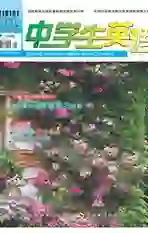中考英语被动语态考点归纳及分析
2016-05-14庄禾
庄禾
英语的语态是通过动词形式的变化表现出来的。英语中有两种语态:主动语态和被动语态。主动语态表示主语是动作的执行者。被动语态表示主语是动作的承受者,即行为动作的对象。被动语态由“助动词be +及物动词的过去分词”构成。解答被动语态题目时,首先要判断主语和动作的关系。如果主语是动作的执行者,就用主动语态;如果主语是动作的承受者,就用被动语态。助动词be有时态、人称和数的变化,其变化通过连系动词be的变化来表现。被动语态否定式为“be not done”。
例如:Chinese is spoken by more and more people in the world. (句中主语Chinese是动词speak的承受者,因此该句使用了被动语态。)
我们在平常尽量使用英语的主动语态,但在以下几种情况下,则通常使用被动语态:
1. 行为主体不明确,不必说出或者无法说出动作的执行者时;
2. 用以强调或突出动作的承受者时;
3. 汉语中含有“据说、据悉、有人说、大家说”等时;
4. 在新闻报道中,用以表明报道的客观性而避免主观性的表达;
5. 在科技文中,用以强调客观事实;
6. 某些内容或特定场合下的习惯用法。
例如:
The glass is broken. (玻璃杯破了。)
The bag was taken away by his sister. (那个袋子是她姐姐提走的。)
It is said that one day he climbed to the top of a house and dropped some money down a chimney. (据说,有一天他爬到一所房子的屋顶上,往烟囱下面扔了一些钱。)
A car accident happened on the high way this morning. Three men were killed, the wounded were taken away to hospital at once and policemen were sent there to cope with the event. (今天早晨高速公路上发生了一起车祸,三人丧生,伤员马上被送往了医院,并马上派了警察去处理这一事件。)
When it is cold enough, water will be turned into ice. (当天气足够冷时,水就会变成冰。)
He was born in October, 1989. (他出生于1989年10月。)
被动语态的人称、数和时态的变化是通过be的变化表现出来的。
1. 一般现在时的被动语态基本结构为“am/ is/ are+动词的过去分词”,通常表示经常性、习惯性的被动动作。例如:
It is known that healthy foods such as fruits and vegetables promote good health. (众所周知,水果和蔬菜等健康食物有益人体健康。)
2. 一般过去时的被动语态基本结构为“was/ were+动词的过去分词”, 表示过去某一时刻的被动性动作。例如:
Look, what an old palace!It was built nearly 800 years ago. (看,多么古老的宫殿!它是约800年前被建造起来的。)
3. 一般将来时的被动语态基本结构为“will/ shall be+动词的过去分词”,表示将来某一时刻的被动性动作。例如:
Another new railway station will be built in 2018. (另一个新的火车站将在2018年建成。)
4. 现在进行时的被动语态基本结构为“am/ is/ are being+动词的过去分词”,表示目前正在被进行的动作。例如:
Please wait while your sound hardware is being tested. (正在测试你的声音硬件,请稍后。)
5. 过去进行时的被动语态基本结构为“was/ were being+动词的过去分词”,表示过去正在被进行的动作。例如:
One police officer said they were being taken to a nearby school. (一名警官说,他们正被送到附近的一所学校。)
6. 现在完成时的被动语态基本结构为“have/ has been+动词的过去分词”, 表示到目前为止已经完成的某个被动性动作。例如:
His family has been informed. (已经通知了他的家人。)
7. 过去完成时的被动语态基本结构为“had been+动词的过去分词”,表示到过去某一时间点为止已经完成的某个被动性动作。例如:
When I got to the theatre, I found the tickets had already been sold out. (我到达剧院时,发现票已卖完了。)
8. 过去将来时的被动语态基本结构为“would be+动词的过去分词”,表示从过去的某一时间来看将来要发生的某个被动性动作。例如:
The manager said the project would be completed by the end of the year. (经理说这个工程在年底前将会完成。)
9. 含情态动词的被动语态其基本结构为“情态动词+be+动词的过去分词”,常表示具有特定感情色彩的被动性动作。情态动词被动语态否定式为“情态动词+not be+动词的过去分词”。例如:
They cannot be created overnight. (这些不可能在一夜之间造就。)
在以下几种情况下不应使用被动语态。
1. 不及物动词、表示状态的动词等不能用于被动语态。
例如:
The story happened in London. (√)
The story was happened in London. (×)
The shirt fits him very well. (√)
He is fitted very well by the shirt. (×)
2. 祈使句,或者由“动词+名词”构成的英语习语等一般不使用被动语态。
例如:
Look at the blackboard, please. (√)
The blackboard is looked at by you. (×)
The boy makes faces in class. (√)
Faces are made by the boy in class. (×)
3. 宾语和主语所指的对象相同,或者反身代词在句中作宾语时,不能使用被动语态。
例如:
We must help each other. (√)
Each other must be helped by us. (×)
You must look after yourself. (√)
Yourself must be looked after. (×)
4. 动词不定式和动词-ing形式,或表示数量、长度、大小、程度、处所、地点、组织时等的单词或短语作宾语时,不能使用被动语态。
例如:
He enjoys listening to the radio. (√)
Listening to the radio is enjoyed by him. (×)
She pays three yuan for the tomatoes. (√)
Three yuan is paid for these tomatoes by her. (×)
He joined the League in 1998. (√)
The League was joined by him in 1998. (×)
1. 语态与主谓一致结合
例如:
Everyone in our class _____ to take part in the English Speech Contest. (2015山东烟台)
A. is encouraged B. encourages
C. are encouraging D. are encouraged
[解析] 主语是Everyone(单数),排除答案C和D项;又因Everyone是encourage这个动作的承受者,因此该句应选用被动语态,排除B项,故选A。
The child without parents _____ good care of by his teachers in this special school. (广东梅州2013)
A. is taken B. are taken
C. take D. takes
[解析]主语the child为单数,与动词短语take care of之间是被动关系,故用一般现在时的被动语态。故选A。
2. 语态与虚拟语气结合
例如:
—Dont you think it necessary that he _____ to Miami but to New York?
—I agree, but the problem is _____ he has refused to.
A. will not be sent; that
B. not be sent; that
C. should not be sent; what
D. should not send; what
[解析] 因为he是动作send的承受者,因此两者之间是被动关系,因此排除D项;而it (is) necessary后的that从句的谓语要用“(should+)动词原形”, 因此排除A项;答句中的表语从句不缺任何句子成分,因此用that,故选B。
3. 语态与倒装句结合
例如:
Only after my friend came _____.
A. did the computer repaired
B. be repaired the computer
C. was the computer repaired
D. the computer was repaired
[解析] 因the computer是动作repair的承受者,因此两者之间是被动关系,排除A项;又因only加状语置于句首,句子部分倒装,排除D和B项,故选C。
4. 在语境中将语态与时态结合起来命题
例如:
—Your scarf feels soft. Did you buy it in China?
—No, I bought it in France. But it _____ in China. (2015云南昆明)
A. is making B. was made
C. makes D. made
[解析] 本题考查的是一般过去时的被动语态。It(the scarf)是与动作make的承受者,因此两者之间是被动关系,应选用被动语态。而由问句中的“Did”以及答句中的“bought”判断应选用一般过去时,故选B。
Should a teenager _____ to get a driving license? (2013贵州安顺)
A. be allow B. allow
C. be allowed D. allowed
[解析] 本题考查的是情态动词的被动语态的用法。而情态动词的被动语态的结构为“情态动词+ be+动词的过去分词”,故选C。
